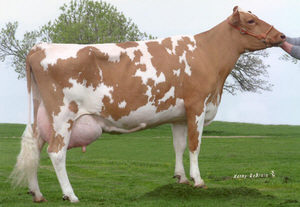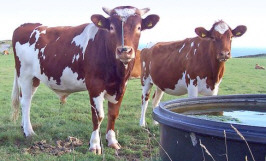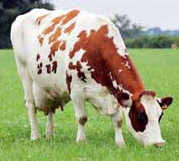



Guernsey
History
The Guernsey originated on the small Isle of Guernsey, situated in the English Channel just off the coast of France. There is no concrete evidence as to the development of the Guernsey before the 19th Century but there may be some truth in the theory that the Isigny cattle of Normandy and the Froment du Léon breed from Brittany were ancestral relatives of the modern Guernsey. Indeed the Jersey, the Guernsey and the Froment du Léon are the only members of the Channel Island sub type of European Blond cattle.The Guernsey was first recorded as a separate breed around 1700. In 1789, imports of foreign cattle into Guernsey were forbidden by law to maintain the purity of the breed although some cattle evacuated from Alderney during World War II were merged into the breed (Spahr and Opperman, 1995).
The Guernsey breed built its reputation for the production of quality milk from grass during the 19th and early 20th centuries and then exported cattle to found significant populations in several other countries. From an original mixed foundation, island breeders concentrated on improving the stock by eliminating faults and making their cattle more homogeneous. All this was based mainly on visual appearance supplemented by some milk recording.
Guernsey's renown as an unique producer of rich yellow coloured milk gave her the title "Golden Guernsey".
Characteristics
 Photo courtesy of Hoards Dairyman farm, http://hoards.com |
Statistics
- Guernseys are efficient converters of feed to product, being of intermediate size, Guernseys produce their high quality milk while consuming 20 to 30 percent less feed per pound of milk produced than larger dairy breeds.
- Guernseys are capable of High Milk Flow.

Photo courtesy of The English Guernsey Cattle Society, guernseycattle.com - Guernseys reach reproductive maturity at an early age and can calve at 22 months of age. This provides an early return on investment.
- Guernseys produce calves big at birth, which are easy to rear.
- Guernseys are well known for having the minimum of calving complications.
- Guernseys are adaptable to all climates and management systems and lack any known undesirable genetic recessive's.
- Her fawn and white coat enhances her heat tolerance and reduces heat stress, which adds to her ability to maintain production levels anywhere.
- They are docile and have an ideal Dairy Temperament.
Comparative
MilkinessResearch carried out in USA has shown that 60% of Guernseys carry the Kappa Casein 'B' gene. This is of real economic benefit to cheese plants, giving a firmer curd, increased volume and better cheese characteristics.
Guernsey milk contains 12% more protein, 30% more cream, 33% more vitamin D, 25% more vitamin A and 15% more calcium than average milk.
96% of Guernsey cows carry the protein Beta Casein A2 in their milk. There is some anecdotal evidence that this protein MAY be better for the health of some people than the Protein Beta Casein A1 that is found in most other milks. PDF
| UK NMR Annual Report 1997/1998 | |||||
| Butterfat% | Protein% | ||||
| Guernsey | 4.81% | 3.59% | |||
| Holstein | 4.02% | 3.19% | |||
Calving
Research has shown that Guernseys have the lowest incidence of calving difficulty of any of the major dairy breeds. This is witnessed by the fact that there is no need for AI companies to indicate 'Calving Ease' bulls in the Guernsey breed. Trials have shown that Guernseys also calve easily even when crossed with heavier beef breeds.
Distribution
 Photo courtesy of The English Guernsey Cattle Society, guernseycattle.com |
References (the above information was cited from the following sites)
www.ansi.okstate.edu
www.worldguernseys.org
http://studbook.co.za
http://www.hoards.com/farm
guernseycattle.com


